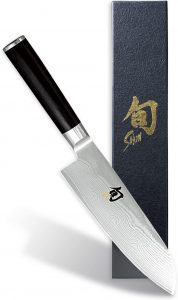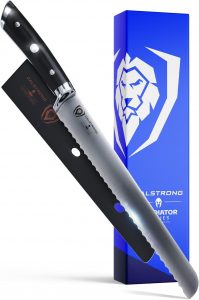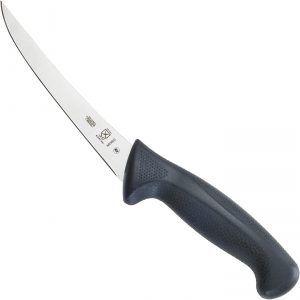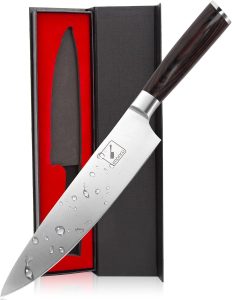Essential Guide to Selecting Top Streaming Devices
A high-quality kitchen knife is a game-changer for every home chef. Whether you’re an amateur cook or a seasoned pro, the right knife can make food prep faster, easier, and safer. A sharp, well-balanced blade allows for precision cutting, minimizing effort and maximizing efficiency.
But with so many knives on the market, how do you know which ones are truly essential? Instead of cluttering your kitchen with unnecessary tools, focus on these seven must-have kitchen knives that will cover all your slicing, dicing, and carving needs.
In this guide, we’ll explore the top 7 kitchen knives every home chef should own in 2025, why they matter, and how to maintain them for years of reliable use.
Types of Kitchen Knives & Their Uses
When it comes to kitchen knives, not all blades are created equal. Each type of knife is designed for specific tasks, ensuring efficiency, precision, and safety in food preparation. Below, we’ll dive deeper into the essential types of kitchen knives, their unique features, and how they can enhance your cooking experience.
1. Chef’s Knife – The Ultimate All-Purpose Blade
What It Is:
A chef’s knife is the most versatile and commonly used knife in any kitchen. It typically features a broad, curved blade between 6 to 12 inches in length, allowing for a rocking motion when cutting.
Best Uses:
✔ Chopping vegetables, fruits, and herbs
✔ Slicing and dicing meat
✔ Mincing garlic and onions
✔ General kitchen tasks
Why You Need It:
If you own only one knife, make it a chef’s knife. It handles nearly all cutting tasks with ease, making it indispensable for both beginner and expert cooks.
2. Santoku Knife – Precision and Efficiency
What It Is:
The Santoku knife is a Japanese-style knife that translates to “three virtues,” referring to its ability to slice, dice, and mince. It has a straighter edge compared to a chef’s knife and usually comes with granton (hollow) edges that prevent food from sticking to the blade.
Best Uses:
✔ Thin, precise slicing of vegetables and meats
✔ Dicing and chopping ingredients with minimal effort
✔ Cutting delicate foods like fish or soft fruits
Why You Need It:
For those who prefer a lighter, more maneuverable knife with excellent precision, the Santoku is an excellent alternative to a chef’s knife.
3. Paring Knife – The Master of Precision
What It Is:
A paring knife is a small knife, usually 2.5 to 4 inches in length, designed for intricate tasks that require control and precision.
Best Uses:
✔ Peeling fruits and vegetables
✔ Trimming fat and removing seeds
✔ Deveining shrimp and segmenting citrus fruits
✔ Creating garnishes and decorative cuts
Why You Need It:
When a chef’s knife is too large for a task, the paring knife steps in. It’s perfect for delicate jobs where accuracy matters.
4. Bread Knife – The Serrated Slicer
What It Is:
A bread knife has a long, serrated blade (typically 8 to 10 inches) designed to cut through soft and crusty bread without crushing it.
Best Uses:
✔ Slicing through crusty artisan bread
✔ Cutting cakes and pastries without tearing them
✔ Slicing tomatoes and other soft-skinned fruits
Why You Need It:
Unlike straight-edged knives, serrated knives grip the surface, allowing for clean cuts through tough exteriors and soft interiors.
5. Boning Knife – For Meat and Fish Lovers
What It Is:
A boning knife has a narrow, sharp, and slightly flexible blade (typically 5 to 6 inches) that makes it easy to separate meat from bone.
Best Uses:
✔ Deboning chicken, beef, pork, and fish
✔ Filleting fish with precision
✔ Trimming fat and removing silver skin from meat
Why You Need It:
If you frequently prepare meat or seafood at home, a boning knife makes the process much easier and helps reduce waste.
6. Utility Knife – The Small Yet Mighty Multi-Tasker
What It Is:
A utility knife is a mid-sized knife (between 4 and 7 inches) that is a cross between a chef’s knife and a paring knife.
Best Uses:
✔ Cutting sandwiches, fruits, and vegetables
✔ Slicing meats and cheese
✔ Trimming and peeling small ingredients
Why You Need It:
For quick, everyday kitchen tasks where a chef’s knife feels too bulky, a utility knife is a great alternative.
7. Carving (Slicing) Knife – The Roast Master
What It Is:
A carving knife (also known as a slicing knife) is a long, thin-bladed knife designed for slicing cooked meats with precision.
Best Uses:
✔ Carving turkey, roast beef, and ham
✔ Slicing smoked salmon or brisket
✔ Creating clean, thin cuts of meat and poultry
Why You Need It:
If you enjoy cooking large roasts or hosting family dinners, a carving knife ensures you get beautifully even slices.
8. Cleaver – The Heavy-Duty Powerhouse
What It Is:
A cleaver is a large, rectangular knife that can handle heavy-duty chopping and cutting tasks, especially for meat and bone.
Best Uses:
✔ Chopping large cuts of meat, including bones
✔ Crushing garlic and ginger
✔ Cutting through tough vegetables like squash
Why You Need It:
A cleaver’s weight and power make it indispensable for butchers and home cooks who frequently work with large meats.
9. Nakiri Knife – The Vegetable Specialist
What It Is:
A Nakiri knife is a Japanese-style knife with a straight, rectangular blade, specifically designed for slicing vegetables with precision.
Best Uses:
✔ Chopping, dicing, and julienning vegetables
✔ Cutting through dense produce like potatoes and carrots
✔ Slicing herbs without crushing them
Why You Need It:
For vegetarians and plant-based cooks, a Nakiri knife offers unmatched precision when preparing vegetables.
10. Steak Knives – Essential for Dining
What It Is:
A steak knife is a small, serrated knife used for cutting cooked meats at the dining table.
Best Uses:
✔ Cutting steaks, pork chops, and grilled meats
✔ Slicing through crusty bread at the table
Why You Need It:
A high-quality steak knife set enhances your dining experience, making it easier to enjoy meat dishes.
How Many Knives Do You Really Need?
If you want a minimalist kitchen setup, these three essential knives will cover 95% of your cooking needs:
1️⃣ Chef’s Knife – For general cutting tasks
2️⃣ Paring Knife – For precision work
3️⃣ Bread Knife – For cutting bread and soft foods
For more advanced home chefs, adding a Santoku knife, boning knife, and carving knife can further enhance your culinary capabilities.
Choosing the right kitchen knives ensures you can prepare meals efficiently, safely, and with precision. Whether you’re a beginner cook or an experienced chef, investing in high-quality knives tailored to your cooking style will make a world of difference.
Now that you know the essential types of kitchen knives, let’s explore the top 7 best kitchen knives for 2025 that every home chef should own!
Top 7 Kitchen Knives for Precision Cooking
Investing in high-quality kitchen knives can make all the difference in your cooking experience. The right knife enhances efficiency, ensures precision, and even improves safety by reducing the need to apply excessive force. Below, we dive deep into the top seven kitchen knives that every home chef should have, including their unique features, best uses, and expert tips for getting the most out of them.
Best Chef’s Knife: Wüsthof Classic 8-Inch Chef’s Knife
A chef’s knife is the single most important tool in any kitchen. Whether you’re chopping onions, dicing carrots, slicing meats, or mincing herbs, this knife does it all. The Wüsthof Classic 8-Inch Chef’s Knife is a top-tier choice for 2025 due to its unparalleled durability and sharpness.
Key Features:
✔ High-carbon stainless steel blade for razor-sharp precision
✔ Full tang construction for perfect balance and control
✔ Ergonomic handle for a comfortable grip during long prep sessions
Best Uses:
✅ Chopping vegetables, fruits, and herbs
✅ Slicing meat and fish
✅ Mincing garlic and onions
✅ General-purpose kitchen tasks
Expert Tip:
Always use a rocking motion when cutting with a chef’s knife to maximize control and efficiency.
Best Santoku Knife: Shun Classic 7-Inch Santoku Knife
A Santoku knife is a Japanese-style knife that specializes in precise slicing, dicing, and chopping. It has a straighter edge than a chef’s knife, making it ideal for an up-and-down cutting motion. The Shun Classic 7-Inch Santoku Knife is the best in its category due to its razor-sharp VG-MAX steel blade and elegant Damascus-clad finish.
Key Features:
✔ Hollow-ground edge (granton edge) prevents food from sticking
✔ Lightweight and perfectly balanced for effortless cutting
✔ Durable VG-MAX steel blade retains sharpness longer
Best Uses:
✅ Slicing vegetables, fish, and meats with precision
✅ Cutting soft foods like cheese and tomatoes
✅ Mincing and dicing without crushing ingredients
Expert Tip:
A Santoku knife is perfect for paper-thin slices, so use a gentle push-cutting motion rather than rocking it like a chef’s knife.
Best Paring Knife: Victorinox 3.25-Inch Paring Knife
A paring knife is a must-have for delicate kitchen tasks that require control and precision. The Victorinox 3.25-Inch Paring Knife is a budget-friendly yet high-quality option that stays sharp and easy to handle.
Key Features:
✔ Super-sharp stainless steel blade for intricate cuts
✔ Lightweight design allows for ultimate control
✔ Non-slip handle ensures a secure grip
Best Uses:
✅ Peeling fruits and vegetables
✅ Deveining shrimp and trimming fat
✅ Slicing small ingredients like strawberries and garlic
✅ Creating garnishes and intricate decorative cuts
Expert Tip:
Use a paring knife for handheld cutting tasks, but always cut on a cutting board for better stability when slicing.
Best Bread Knife: Dalstrong Serrated Bread Knife 10-Inch
A bread knife is designed with a serrated edge to cut through crusty bread without crushing the soft interior. The Dalstrong Serrated Bread Knife stands out with its extra-long 10-inch blade and superior edge retention.
Key Features:
✔ Serrated edge for effortless slicing through crusty or delicate foods
✔ High-carbon stainless steel blade for long-lasting sharpness
✔ Full tang construction for enhanced durability and balance
Best Uses:
✅ Cutting through loaves, baguettes, and sourdough bread
✅ Slicing delicate cakes and pastries without damaging them
✅ Slicing soft-skinned fruits like tomatoes and citrus
Expert Tip:
Use a sawing motion rather than pressing down when using a bread knife to ensure clean cuts.
Best Boning Knife: Mercer Culinary Millennia 6-Inch Boning Knife
A boning knife is designed for removing meat from bones, filleting fish, and trimming fat. The Mercer Culinary Millennia Boning Knife is an affordable, professional-grade knife that offers precision and flexibility.
Key Features:
✔ Thin, semi-flexible blade for maneuverability around bones
✔ Ergonomic, slip-resistant handle for secure grip
✔ Razor-sharp edge for precise cutting
Best Uses:
✅ Deboning chicken, beef, and pork
✅ Filleting fish with precision
✅ Removing silver skin from meat
Expert Tip:
For the best control, use the tip of the boning knife to make small, precise cuts while keeping the blade close to the bone.
Best Utility Knife: Global 6-Inch Utility Knife
A utility knife fills the gap between a chef’s knife and a paring knife. The Global 6-Inch Utility Knife is lightweight, razor-sharp, and perfect for everyday kitchen tasks.
Key Features:
✔ Lightweight stainless steel design for effortless handling
✔ Well-balanced blade for precise cutting
✔ Hollow handle filled with sand for perfect weight distribution
Best Uses:
✅ Slicing sandwiches, meats, and cheese
✅ Chopping herbs and small vegetables
✅ Cutting citrus fruits and other medium-sized ingredients
Expert Tip:
Use a utility knife when a chef’s knife feels too big for the task, but a paring knife feels too small.
Best Budget Knife: Imarku 8-Inch Chef’s Knife
If you’re looking for a reliable, high-quality knife on a budget, the Imarku 8-Inch Chef’s Knife is a fantastic choice. It offers impressive performance at an affordable price.
Key Features:
✔ High-carbon stainless steel blade for sharpness and durability
✔ Ergonomic wooden handle for comfortable grip
✔ Multi-purpose knife suitable for beginners and everyday cooks
Best Uses:
✅ General chopping, slicing, and dicing
✅ Cutting meats and vegetables with ease
✅ A great starter knife for beginners
Expert Tip:
Even a budget knife will last longer if you hand wash it and hone it regularly instead of relying on a dishwasher.
Final Thoughts on Choosing the Best Kitchen Knives
Each of these seven kitchen knives plays a unique role in the kitchen, ensuring efficiency, precision, and comfort in food preparation. If you want to invest in just a few knives, start with these three:
1️⃣ Chef’s Knife – The all-purpose workhorse
2️⃣ Paring Knife – For detailed precision work
3️⃣ Bread Knife – For perfect slices of bread and soft-skinned foods
For serious home chefs, adding a Santoku, boning, and utility knife will further enhance your culinary skills.
How to Maintain Your Kitchen Knives for Longevity
Investing in high-quality kitchen knives is only the first step to a better cooking experience. Proper maintenance ensures your knives stay razor-sharp, durable, and safe to use for years to come. Here’s everything you need to know about keeping your knives in top condition through correct cleaning, sharpening, storage, and usage techniques.
1. Hand Wash Only – Avoid the Dishwasher
One of the biggest mistakes people make with their kitchen knives is putting them in the dishwasher. While it may seem convenient, the high heat, harsh detergents, and jostling inside the dishwasher can damage the blade and handle.
Why Dishwashers Are Bad for Knives:
❌ Heat and moisture can warp wooden handles
❌ Blades can knock against other utensils, causing dulling or chipping
❌ Harsh detergents corrode and degrade the metal over time
Best Way to Wash Your Knives:
✔ Use warm water, mild dish soap, and a soft sponge
✔ Wash immediately after use to prevent food acids from corroding the blade
✔ Dry thoroughly with a clean towel before storing
Pro Tip:
If you need to remove stubborn residue, soak the knife in warm water for a few minutes—but never leave it submerged for too long, especially if it has a wooden handle.
2. Hone Your Knife Regularly
Many people confuse honing and sharpening—but they are different! Honing realigns the knife’s edge, keeping it straight and sharp, while sharpening removes metal to create a new edge.
How to Hone Your Knife:
1️⃣ Hold a honing rod vertically with the tip on a cutting board
2️⃣ Place the knife against the rod at a 15-20 degree angle
3️⃣ Gently slide the blade down and across the rod from heel to tip
4️⃣ Repeat on the other side (5-10 times per side)
How Often to Hone:
🔹 Every few uses (for frequently used knives like a chef’s knife)
🔹 Once a week (for less frequently used knives)
Pro Tip:
A honing steel does not sharpen your knife—it simply keeps the edge straight! You’ll still need to sharpen your knives periodically.
3. Sharpen Your Knife When Needed
Even with regular honing, knives will eventually lose their sharpness and need sharpening. A dull knife is actually more dangerous than a sharp one because it requires more force, increasing the risk of slipping.
Signs Your Knife Needs Sharpening:
🔪 It struggles to cut through tomatoes or onions
🔪 You have to use extra pressure to slice meat
🔪 It no longer glides effortlessly through food
Best Ways to Sharpen a Knife:
1️⃣ Whetstone (Best for Longevity)
✔ Provides the most precise sharpening
✔ Removes minimal metal, extending the knife’s lifespan
✔ Ideal for high-quality chef’s knives
How to Use a Whetstone:
- Soak the stone in water for 10-15 minutes (if using a water stone).
- Place the stone on a non-slip surface.
- Hold the knife at a 15-20 degree angle and slide it along the stone.
- Repeat on the other side until sharp.
2️⃣ Electric or Manual Knife Sharpener (Quick & Convenient)
✔ Fast and easy to use
✔ Good for regular home cooks
✔ Not as precise as a whetstone
3️⃣ Professional Sharpening Service (Best for High-End Knives)
✔ Ensures a professional-grade edge
✔ Recommended for expensive knives once or twice a year
Pro Tip:
If you feel uncomfortable sharpening your knife, have it professionally sharpened instead of using cheap pull-through sharpeners, which can wear down the blade too quickly.
4. Store Knives Properly to Prevent Damage
How you store your knives is just as important as how you use them. Storing them incorrectly can cause dull edges, chipped blades, and even safety hazards.
Best Knife Storage Options:
1️⃣ Knife Block (Classic and Safe)
✔ Protects blades from damage
✔ Keeps knives organized and easy to access
✔ Prevents dulling from contact with other utensils
🔹 Tip: Always place knives in the block with the blade facing up to reduce friction.
2️⃣ Magnetic Knife Strip (Space-Saving & Hygienic)
✔ Prevents moisture buildup (no bacteria growth)
✔ Keeps knives easily accessible
✔ Saves counter space
🔹 Tip: Choose a strong, smooth-surface magnetic strip to prevent unnecessary scratches.
3️⃣ Knife Guards (Best for Drawer Storage)
✔ Protects blades when stored in a drawer
✔ Prevents accidents when reaching for knives
✔ Affordable and easy to use
🔹 Tip: Avoid tossing knives into a drawer without protection—they’ll dull faster and can be hazardous.
5. Use the Right Cutting Board
Not all cutting boards are knife-friendly. Some materials can quickly dull your knife’s edge, leading to more frequent sharpening.
Best Cutting Board Materials:
✅ Wood (Best Choice) – Soft enough to preserve sharpness while durable enough to last
✅ Bamboo – Slightly harder than wood but still knife-friendly
✅ Plastic – Good for raw meats (since it’s easier to sanitize)
Worst Cutting Board Materials:
❌ Glass – Dulls and chips blades quickly
❌ Marble or Stone – Hard surfaces destroy sharp edges
❌ Metal – Harsh on blades and causes excessive wear
Pro Tip:
Use separate cutting boards for raw meats and vegetables to prevent cross-contamination.
6. Avoid Misusing Your Knives
Even the best knives can be damaged if used incorrectly. To keep your knives in peak condition, never use them for tasks they weren’t designed for.
Things to Avoid:
❌ Don’t use knives to cut frozen foods (this can cause chipping)
❌ Avoid using knives as can openers, screwdrivers, or bottle openers
❌ Never scrape food off the cutting board with the knife blade (use the spine instead)
Pro Tip:
A cleaver is the best knife for cutting through bones—never use a chef’s knife for this, as it can lead to serious damage.
7. Keep Knives Dry to Prevent Rusting
Even high-quality stainless steel knives can rust if not properly cared for. Moisture and acidic foods are the biggest culprits behind rust spots.
How to Prevent Rust:
✔ Dry knives immediately after washing—don’t leave them in the sink
✔ Apply a thin coat of mineral oil on carbon steel knives to protect them
✔ Store in a dry place (never leave knives near the sink or dishwasher)
Pro Tip:
If rust appears, remove it with a baking soda and water paste—gently rub with a soft cloth and rinse.
7. Keep Knives Dry to Prevent Rusting
Even high-quality stainless steel knives can rust if not properly cared for. Moisture and acidic foods are the biggest culprits behind rust spots.
How to Prevent Rust:
✔ Dry knives immediately after washing—don’t leave them in the sink
✔ Apply a thin coat of mineral oil on carbon steel knives to protect them
✔ Store in a dry place (never leave knives near the sink or dishwasher)
Pro Tip:
If rust appears, remove it with a baking soda and water paste—gently rub with a soft cloth and rinse.
Maintaining your kitchen knives doesn’t take much effort, but it significantly extends their lifespan and ensures they remain sharp, safe, and effective.
Key Takeaways for Knife Maintenance:
✔ Always hand wash and dry immediately
✔ Hone regularly and sharpen when necessary
✔ Use a proper cutting board to preserve sharpness
✔ Store knives safely in a block, magnetic strip, or with blade guards
✔ Avoid improper use to prevent damage
By following these simple tips, you’ll protect your investment and ensure your knives perform at their best for years to come.
FAQs: Answering Your Common Kitchen Knife Questions
Choosing and maintaining kitchen knives can be overwhelming, especially with so many options available. Here, we answer some of the most frequently asked questions to help you make informed decisions about your knives.
1. What is the best knife for a beginner cook?
For beginners, the best knife to start with is an 8-inch chef’s knife. It’s versatile, easy to handle, and can perform 80-90% of kitchen tasks. A great option is the Victorinox Fibrox Pro 8-Inch Chef’s Knife—it’s affordable, high-quality, and comfortable to use.
Beginner’s Knife Must-Haves:
✅ Lightweight yet durable
✅ Comfortable grip for better control
✅ Sharp edge that stays sharp longer
2. How often should I sharpen my knife?
The frequency of sharpening depends on how often you use your knife.
✔ Daily use: Sharpen every 2-3 months
✔ Occasional use: Sharpen every 6 months
✔ Rare use: Sharpen at least once a year
Honing vs. Sharpening:
🔪 Honing (using a honing rod): Helps maintain sharpness by realigning the blade—should be done weekly.
🔪 Sharpening (using a whetstone or sharpener): Restores a dull blade—should be done every few months.
3. What’s the difference between a chef’s knife and a Santoku knife?
While both knives are multi-purpose, they have some key differences:
| Feature | Chef’s Knife | Santoku Knife |
|---|---|---|
| Blade Shape | Curved, allows for rocking motion | Flatter edge, best for straight slicing |
| Length | Typically 8-10 inches | Typically 5-7 inches |
| Best For | Chopping, slicing, dicing all ingredients | Precision slicing, fine mincing, vegetable prep |
| Edge Type | Straight edge | Hollow-ground (granton) edge prevents sticking |
4. Should I get a full knife set or buy individual knives?
This depends on your cooking style.
✔ If you cook daily and need variety: A knife set is a good investment.
✔ If you only cook occasionally: Buy individual knives that fit your specific needs.
Essential Knives for a Starter Set:
🔹 Chef’s knife – The most versatile option
🔹 Paring knife – For small, intricate cuts
🔹 Bread knife – A must-have for bread and soft fruits
🔹 Utility knife – Great for everyday slicing
5. What is the best knife material?
The material of the knife determines its durability, sharpness, and maintenance needs.
| Material | Pros | Cons |
|---|---|---|
| High-Carbon Stainless Steel | Extremely sharp, rust-resistant, holds edge well | More expensive |
| Stainless Steel | Affordable, rust-resistant | Requires frequent sharpening |
| Carbon Steel | Super sharp, easy to sharpen | Prone to rust, needs maintenance |
| Ceramic | Ultra-sharp, lightweight, doesn’t rust | Can chip or break easily |
6. What are the biggest mistakes people make with kitchen knives?
❌ Putting them in the dishwasher (heat and friction dull the blade)
❌ Using the wrong cutting board (glass and marble boards destroy sharpness)
❌ Storing knives loosely in a drawer (causes nicks and dulling)
❌ Not honing regularly (blades get misaligned faster)
❌ Using a dull knife (more dangerous than a sharp one)







